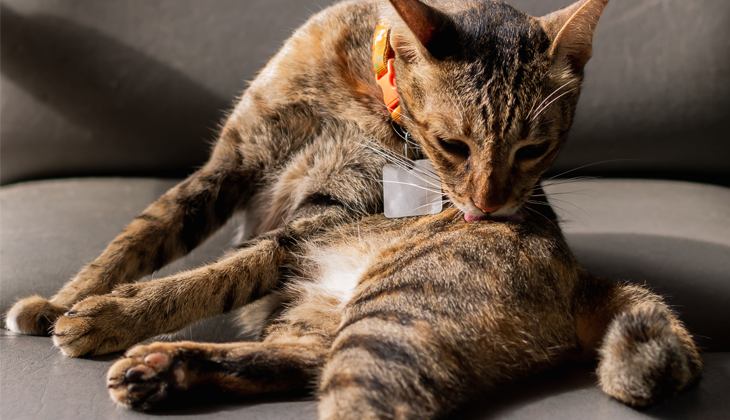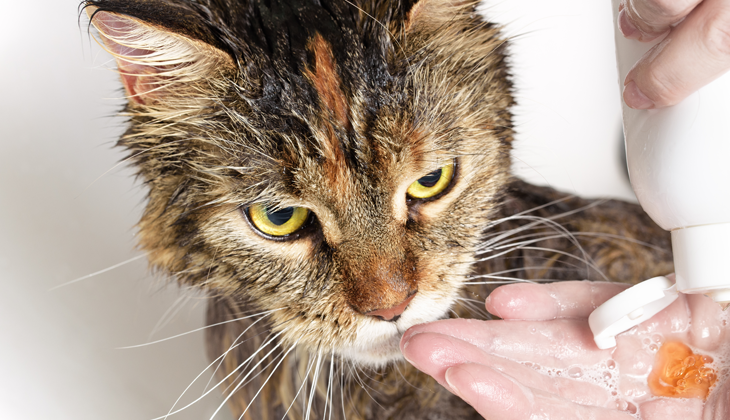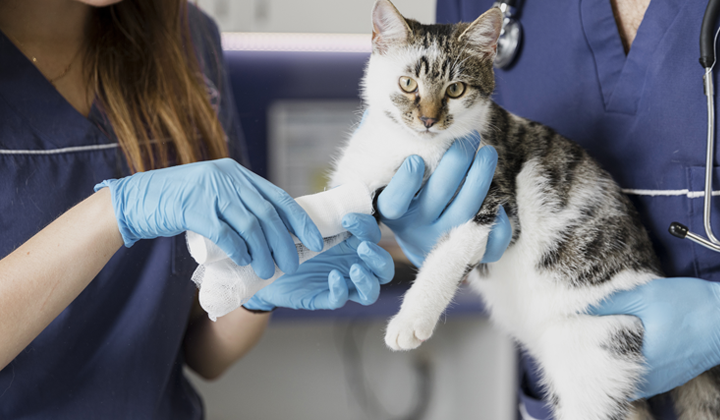Your Itchy, Scratchy Cat
HEALTH & PROTECTION
10 Sept, 2024
13 minutes

Time to snuggle up but your cat doesn’t stop scratching. You might notice patches of missing fur, or maybe you see that your cat’s skin is scaly in certain spots. Your cat may also seem restless and uncomfortable, and you’re concerned there might be something wrong with your cat’s skin.
There are a variety of skin issues that commonly affect our feline companions. Your veterinarian will be able to diagnose your cat’s problem but it’s good to know what to look for and understand how each skin ailment is handled.

Mange
Mange is a skin disease caused by several species of tiny mites, some of which naturally live in the hair follicles of the skin. The good news is that, despite popular belief, most types of feline mange are uncommon. The confusion comes from the fact that far more common conditions like flea infestations have the same signs as mange. This can include itching, hair loss, dry and/or red skin and excessive licking and grooming but also restlessness and irritability.
There are five types of mites that can affect cats:
- Ear mites (Otodectes cynotis) – Otodectic mange is quite common in cats, although most people call this ear mites rather than mange. These mites, as their name suggests, infest the ears of cats and cause itching, irritation and inflammation. If your cat seems to have head lesions, dirty, itchy ears and is scratching or shaking its head a lot it might have ear mites.
- “Walking dandruff” (Cheyletiella spp.) – Cheyletiellosis is caused by mites that live on the surface and in the superficial layers of the skin. Infections can be asymptomatic or lead to scaling, itching and crusting on the back, with very few mites needed to cause signs. This mite is more common in rabbits than in cats.
- Demodectic Mange (Demodex cati mites) – Demodex cati is not contagious and normally lives in the skin of cats. This mite only causes problems in cats with underlying immune system issues or systemic disease where mite numbers increase, and skin lesions develop. It is sometimes seen in young kittens and older cats.
- Sarcoptic Mange (Sarcoptes scabiei mites) – This is a less common cause of mange. It is highly contagious and can be acquired by cats that encounter infected wildlife or other animals (like dogs) and can even be transferred to humans.
- Notoedric Mange (Notoedres cati mites) – Also known as “Feline Scabies”, this type of mange is very uncommon but highly contagious to cats and humans.

How is Mange Treated?
The treatment regimen will vary depending on the type of mite your cat has. Your veterinarian will prescribe medication to kill the mites. This medication may need to be applied into the ear, topically, or by injection, shampooing or dipping. You may need to isolate your cat within your home to prevent spread to humans or other pets. Additional treatment, such as antibacterial shampoo or antibiotics, may be required in severe infections. Although the mites are quickly killed, the secondary skin infections may take at least a month to clear up.
Since mange is complex and most types are uncommon, it is imperative that your veterinarian make a diagnosis before you begin any treatment program for mange. The diagnosis is made by observing the mites in a skin or swab sample under the microscope. Your veterinarian will be able to diagnose whether your cat has fleas or mites and which type. Insecticides, collars and dips containing permethrin or amitraz that are labeled for dogs are toxic to cats.
How can I prevent Mange in my cat?
Most healthy house cats are at low risk of mange. Just like flea control, maintaining a clean environment by washing your cat’s bedding and vacuuming your home regularly are simple measures that go a long way toward mange prevention.
Fleas
There are more than 2,200 species of fleas recognized worldwide and they are a major cause of itching for cats. For more information on fleas, please be sure to check out our articles:
- How To Tell If Your Cat Has Fleas? Here Are 9 Signs
- How Cats Get Fleas Indoors
- How to protect your cat from fleas and ticks
Flea Allergy Dermatitis
This condition is the result of an allergic reaction to a flea’s saliva when it bites. Bumps and crusts can appear on your cat’s back, neck and face and can be quite severe, especially if exacerbated by repeated licking, scratching and chewing. Cats with flea allergy dermatitis (FAD) may have hair loss, open sores or scabs on their skin and can develop bacterial infections.

What is the Treatment for Flea Allergy Dermatitis?
As with flea infestation, the best course of treatment is flea treatment and control. There are many effective products available, for treating and controlling fleas on your cat and in your home.
How Can I Tell My Cat Has Ringworm?
Recognizing ringworm on your cat can be very challenging. Some cats may have ringworm without any clinical signs. You may see what looks like ash in your cat’s coat, or sparse, or even generalized, thickened patches of hairless crusted skin. Infected claws may become rough, pitted or even deformed with a scaly base. Any infected cat, whether it has signs or not, can still infect humans and other animals.
How Does Ringworm Spread?
Ringworm is transmitted by direct contact with an infected animal or person, contaminated objects or surfaces.
Contact with the ringworm fungus does not always result in infection. Healthy animals and humans are usually resistant to infection. The elderly and young children are especially susceptible, as are individuals with compromised immune system or skin problems. Contact your family physician immediately if you or any of your family members develop suspicious skin lesions.
How is My Cat’s Ringworm Treated?
Your veterinarian may prescribe topical (ointments, creams, or shampoos) and/or oral antifungal medications for your cat. Thoroughly cleaning your home while also minimizing exposure of humans and other pets is recommended.
Ringworm (dermatophytosis), is a superficial skin infection caused by fungi called dermatophytes. Contrary to its name, this infection is not caused by a worm and the skin lesions are not always circular. In cats, the infection affects the skin, fur and/or claws. Ringworm can also infect and other animals.
Feline Atopy
Atopy, also known as atopic dermatitis, occurs when an allergic response occurs to airborne substances, such as pollen or house dust. Your cat may start to rub, lick, bite or scratch frequently if it is itchy.
How is Feline Atopy Treated?
To arrive at a diagnosis of atopy, your veterinarian will rule out other more common skin conditions with similar signs, including fleas, ringworm, mites and lice.
Managing atopy will vary depending on how severely affected your cat is. Your veterinarian may prescribe food supplements for the skin or medication to make your cat less itchy. Avoiding certain allergens, if confirmed, may be possible.

Your Cat’s Itch
Regardless of the cause, no one wants to see their beloved feline companion uncomfortable. If you suspect your cat has a skin condition, the best thing you can do is consult your veterinarian.
RECOMMENDED
RELATED POSTS
-

Finding out your dog or cat has diabetes can be a lot to digest, learn all the terms so you can ask the right questions and stay on top of your pet’s needs.
-

Pets do not understand the holidays period which change their routines. Here are 6 tips to create a pet friendly home during Chrismas!
-

It is important to know about rabies and how to protect our families. Protect your pet from rabies with an up-to-date vaccination from your veterinarian.
-

Your beloved cats can also suffer from cold and flu. In this article learn how to protect your cat during cold periods.






